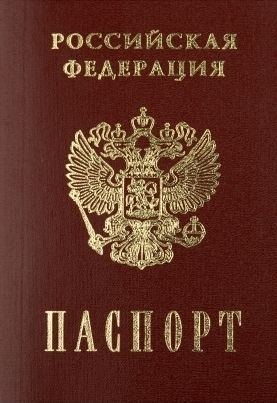Issued by Russia Eligibility requirements 14 years of age | Purpose Identity | |
 | ||
Expiration Renewed at age 20 and 45 Cost 300 rubles, 1500 rubles in case of loss or damage | ||
The Internal Russian passport (officially in Russian: Паспорт гражданина Российской Федерации, commonly referred to as внутренний паспорт, общегражданский паспорт) is an identity document for Russian citizens who are aged 14 or over.
Contents
History
In 1992, passports – or other photo identification documents – became necessary to board a train. Train tickets started to bear passenger names, allegedly, as an effort to combat speculative reselling of the tickets.
On 9 December 1992, special pages were introduced which were affixed in Soviet passports, certifying that the bearer of the passport was a citizen of Russia. These pages were optional unless travelling to the other former Soviet republics which continued to accept Soviet passports; for other occasions, other proofs of citizenship were accepted as well. Issuance of the pages continued until the end of 2002.
On 8 July 1997, the currently-used design of the Russian internal passport was introduced. Unlike the Soviet passports, which had three photo pages, the new passports only have one. A passport is first issued at the age of 14, and then replaced upon reaching the ages of 20 and 45. The text in the passports is in Russian, but passports issued in autonomous entities may, on the bearer's request, contain an additional page duplicating all data in one of the official local languages.
A deadline for exchanging old passports for the new ones was initially set at year-end of 2001, but then extended several times and finally set at 30 June 2004. The government had first regulated that having failed to exchange one's passport would constitute a punishable violation. However, the Supreme Court ruled to the effect that citizens cannot be obliged to exchange their passports. The Soviet passports ceased to be valid as means of personal identification since mid-2004, but it is still legal (though barely practical) to have one.
The propiska was formally abandoned soon after adoption of the current Constitution in 1993, and replaced with "residency registration" which, in principle, was simply notification of one's place of residence.
Nevertheless, under the new regulations, permanent registration records are stamped in citizens' internal passports just as were propiskas. This has led to the widespread misconception that registration was just a new name for the propiska; many continue to call it "propiska". This misconception is partly reinforced by the fact that the existing rules for registration make it an onerous process, dependent on the consent of landlords, which effectively prevents tenants of flats from registering.
Internal Russian passports are issued only inside the country. Russian citizens who live abroad can get internal passport only if they visit Russia, i.e., it is not possible to get internal passport in the Russian consulate abroad. In practice, Russian citizens who live abroad often do not get new internal passports at all, as the law allows them to prove their identity with an international Russian passport (travel document).
Replacement with identity cards
In November 2010 the Ministry of Internal Affairs announced the cancellation of internal passports, replacing them with plastic identity cards or driver's licenses. Starting from March 1, 2018, the new cards will be issued to every citizen of the Russian Federation, which supposed to replace old booklet documents completely by 2025.
